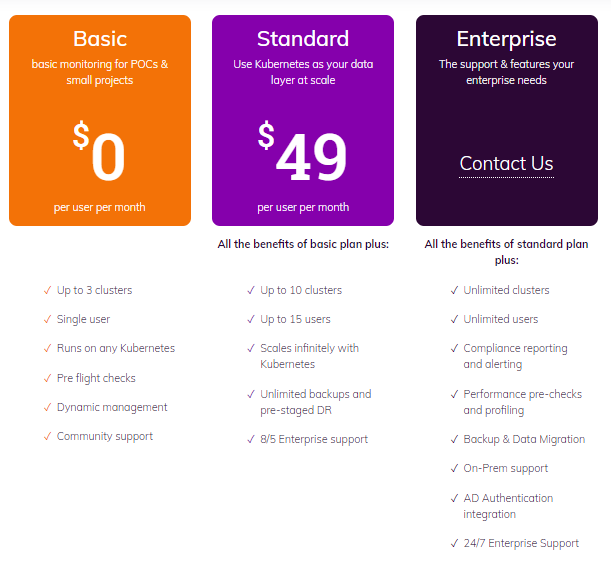Overview: Kubera
TL;DR - Kubera is SaaS that makes it easy to use Kubernetes itself as your data layer. It is free forever for individual use. Get started here: kubera.mayadata.io
Over the last few years Kubernetes has increasingly been selected as the right platform to use as a data layer - and the approach we call Container Attached Storage has become prevalent.
OpenEBS - both as a storage layer and as a means to dynamically provision and manage local disk directly for those workloads that are already resilient such as Cassandra - has proliferated. And so have those users that have asked for a little bit more help in operating Kubernetes as a data layer.
Today, we release Kubera - a SaaS service with an on-premise edition available - that addresses many of those requests for more operations help. Kubera delivers:
Care and feeding of Kubernetes as your data layer
- Kubera simplifies and automates common workflows such as upgrading workloads and upgrading OpenEBS itself, which reduces operational costs while increasing the resilience of the environment
- Kubera includes off cluster logging, reporting, visualization, and alerting which saves time and money while improving operations
- Kubera also can help you see and manage underlying environments, making sure for example that you are deploying across availability zones and that dynamic provisioning of these underlying resources is working as you would like, once again saving costs while increasing resilience.
Long term and 24-7 enterprise support
- The OpenEBS Enterprise Edition - 100% open source - is MayaData’s build of the underlying OpenEBS project and helps us to meet the needs of users that do not want to upgrade their data layer as frequently.
- MayaData provides support for users via Kubera - including live chat that connects users to the large MayaData team 24x7, 365 days a year. Kubera enables close collaboration between MayaData engineering and Kubera and OpenEBS users by providing a shared context that support-only and traditional proprietary on-premise only solutions cannot match.
Back ups, disaster recovery, and other resilience
- Kubera now supports simple back-up of any workload, whether it is running on OpenEBS or not. This especially applies to those stateful set deployments where you might want the high performance of OpenEBS LocalPV plus the resilience of replication off of the node and off of the cluster.
- By the way, community member Gabriele Bartolini recently published a benchmarking blog about the use of OpenEBS Dynamic LocalPV for performance under PostgreSQL here: https://www.2ndquadrant.com/en/blog/local-persistent-volumes-and-postgresql-usage-in-kubernetes/
One more thing: Mayastor
- Mayastor is the first Kubernetes native storage solution to embrace and extend NVMe to deliver per workload storage services. While Mayastor remains early, we already have hundreds of users putting it through its paces, so we have added initial support of Mayastor within Kubera. https://go.mayadata.io/openebs-performance-may-webinar
To see a live demo of Kubera being used to operationalize Container Attached Storage - including simple upgrades, troubleshooting, per workload monitoring, backups and data migration and more - please join this webinar: https://go.mayadata.io/kubera_launch_webinar
Here is the canonical table on what Kubera delivers and the differences between the individual, team and enterprise versions:
 On behalf of the entire team here at MayaData, thank you for all your support over the last few years. I’m extremely excited about Kubera as a superior way to operate Kubernetes as a data layer. I hope it helps unlock for you the promise of true data agility.
On behalf of the entire team here at MayaData, thank you for all your support over the last few years. I’m extremely excited about Kubera as a superior way to operate Kubernetes as a data layer. I hope it helps unlock for you the promise of true data agility.
One more thought - many of my friends from the storage industry pointed out in the past that OpenEBS, in some ways, is a bit like VMware’s VSAN. I wrote a blog on that comparison because I do think it is apt. Whereas vSAN runs on vSphere to deliver data services primarily to workloads running on vSphere - OpenEBS runs on Kubernetes to deliver data services primarily to workloads running on Kubernetes. In talking with friends in the storage industry about Kubera a couple of them said - ahaha! - it’s like vRealize Operations or maybe like a collection of other capabilities bundled and sold as vSphere itself. Once again we had NOT built the solution based on what VMware built and bought and assembled however the analogy again seems fairly apt with the proviso that Kubera focuses on the use of Kubernetes as a data layer as opposed to overall management. Feedback, as always, welcome and appreciated.






Game changer in Container and Storage Paradigm- MayaData gets acquired by DataCore Software
Don Williams
Don Williams
Managing Ephemeral Storage on Kubernetes with OpenEBS
Kiran Mova
Kiran Mova
Understanding Persistent Volumes and PVCs in Kubernetes & OpenEBS
Murat Karslioglu
Murat Karslioglu